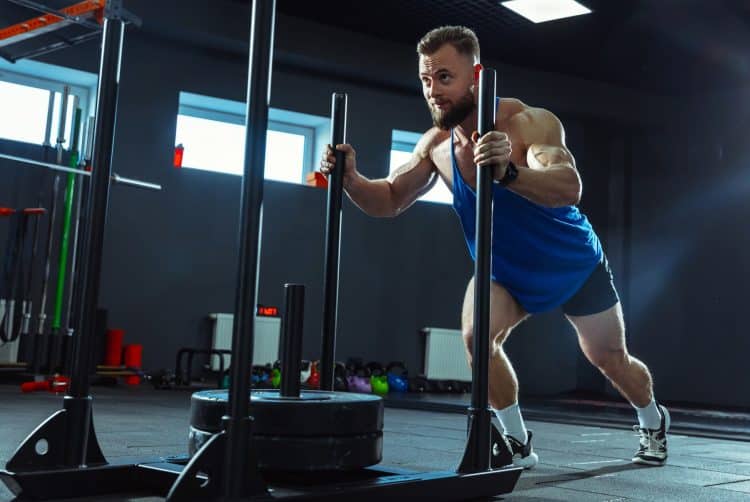Most bodybuilders train using a body part split. This means they work different muscle groups on different days. For example, chest on Monday, back on Tuesday, legs on Thursday, and shoulders and arms on Friday.
Such a split means that every major muscle group is trained once per week.
Some lifters train their muscles a little more often, perhaps two or even three times a week. Examples of this are full-body workouts and push-pull routines.
These workouts are best described as a low-frequency, high-volume approach to training.
While there is no denying training this way works, that doesn’t mean it’s the only way to organize your workouts. High-frequency, low-volume training is the opposite end of the workout spectrum and could be a viable alternative for some exercisers.
In this article, we explain what high-frequency, low-volume training is, list the benefits, and provide you with some sample workouts to try.
Level Up Your Fitness: Join our 💪 strong community in Fitness Volt Newsletter. Get daily inspiration, expert-backed workouts, nutrition tips, the latest in strength sports, and the support you need to reach your goals. Subscribe for free!
What is High-Frequency, Low-Volume Strength Training?
High-frequency, low-volume strength training is pretty self-explanatory. It’s also a bit of a mouthful, so, for the purposes of this article, we’ll be using the abbreviation HFLV.
The aim of any split routine is to spread your training volume over several workouts. Exercises are usually grouped by body part, so you’ll have a leg workout, a chest workout, a back workout, etc., each week.
Each workout involves several exercises, and each exercise is done for several sets. This allows you to accumulate plenty of muscle-building training volume per week.
HFLV training takes that same weekly training volume but divides it evenly across more workouts. So, instead of doing 12-15 sets of chest training in a single session, you might do 2-3 sets of chest per workout 5-6 days per week.
So, each week, you do roughly the same number of exercises and sets per muscle group, but instead of cramming all that work for each body part into a couple of weekly workouts, it’s spread over more training sessions.
For example:
| Monday | Tuesday | Wednesday | Thursday | Friday | Saturday |
| Upper body push | Upper body push | Upper body push | Upper body push | Upper body push | Upper body push |
| Upper body pull | Upper body pull | Upper body pull | Upper body pull | Upper body pull | Upper body pull |
| Legs | Legs | Legs | Legs | Legs | Legs |
Each workout involves different exercises to ensure muscular and structural balance and avoid overuse injuries. Just imagine your normal chest, leg, back, etc., workout, but instead of doing it all in one session, you divide it evenly over your training week.
While this approach flies in the face of traditional bodybuilding training, it mirrors the way that many Olympic lifters and gymnasts train, and it’s an approach that’s extremely popular with calisthenic athletes.
That’s not to say that HFLV training is better than the more common approach to bodybuilding. Studies suggest that training volume and intensity rather than frequency are the most critical factors for building muscle (1, 2).
However, because your body adapts so readily to almost any training stimulus, it’s always useful to have alternative approaches available so you can vary your workouts, avoid plateaus, and maintain your progress.
Also, for some people, HFLV training may be more convenient and enjoyable than regular bodybuilding training.
The Benefits of High-Frequency, Low-Volume Strength Training
If you are used to following a traditional split training approach to bodybuilding, you may be skeptical about the validity of such an unusual workout system.
However, there are plenty of benefits to HFLV training:
1. Higher average training intensity per week
When you do several exercises per muscle group and several sets per exercise per body part, by the end of your workout, your muscles will be tired, so you won’t be able to lift much weight or do as many reps. For example:
- Bench press – feeling strong, high energy
- Incline dumbbell bench press – a little tired, energy still pretty good
- Dumbbell flyes – getting tired now, weights feeling heavy
- Chest press machine – lots of fatigue, very low energy
- Cable crossovers – really tired now, only just able to complete the workout
For this reason, most good programs frontload your workouts, so the most challenging and productive exercises are at the start, and the easier exercises come at the end.
But, with a HFLV workout, you only do one exercise and a couple of sets per muscle group per workout. That means you won’t have to contend with rising fatigue levels. Instead, you can use heavier weights and do more reps for ALL the exercises per muscle group simply by doing them on different days.
2. Lower RPE per workout
RPE is short for Rating of Perceived Exertion and is a scale from 1-10 used to describe how hard a workout feels. Doing several exercises for multiple sets usually leads to a high RPE as there is a lot of localized fatigue. That RPE will climb as training volume increases.
With HFLV training, workout RPE is usually lower. Doing fewer exercises and sets per workout means you won’t feel as tired. So, despite an average increase in weekly training intensity, your workouts will feel easier.
A lower RPE means you are less likely to dread your coming workout and should feel motivated to put in more effort. After all, how hard can just one exercise for a particular muscle group be? It’ll be over before you know it!
3. Less muscle soreness
High-volume, low-frequency workouts are normally associated with severe muscle soreness. All those exercises and sets really take a lot out of your body. Muscle soreness typically kicks in 24-48 hours after a workout and lasts 3-7 days, depending on how hard you trained. IN some cases, it can be very debilitating.
HVLF training is less likely to produce much muscle soreness. The workouts aren’t voluminous enough to cause a lot of post-exercise pain, and training the same muscle groups daily will help ward off soreness, too.
Not convinced? Think about this: which will result in more pain, running a marathon today, or running a few miles every day to cover the same distance over a week? The answer is actually pretty obvious, and we can apply the same rationale to strength training.
4. Shorter workouts
Spreading the same weekly training volume over more workouts means that each training session can be shorter. So, if you usually train for 90 minutes four times a week, you can cut the length of each workout to 60 minutes if you train six times a week.
However, you can probably reduce the length of your workouts even more because the training intensity is higher. You won’t need to do as many sets per exercise to trigger hypertrophy.
For example, you might normally do 4-5 sets per exercise when you follow a split routine, but with HFLV training, 2-3 sets should be sufficient.
After all, you’ll probably be hitting that same muscle group tomorrow. Doing more than a couple of sets will impede recovery and make your next workout less productive. As such, you may find that 30-45 minutes is more than long enough for daily HFLV training.
Directly or indirectly, these benefits may mean that you get better results from HFLV training than a more traditional bodybuilding split.
Level Up Your Fitness: Join our 💪 strong community in Fitness Volt Newsletter. Get daily inspiration, expert-backed workouts, nutrition tips, the latest in strength sports, and the support you need to reach your goals. Subscribe for free!
That’s especially true if you’ve been following a standard approach to bodybuilding training for a long time and your progress is slowing or has come to a complete halt. HFLV training is so novel that it could reignite your progress and get you back on the gains train.
Sample High Frequency, Low Volume Strength Training Program – Weights
This program is designed for lifters with access to a well-equipped gym. Each workout consists of three main exercises (push, pull, legs) plus a couple of ancillary exercises to plug any developmental gaps.
If you are really short of time, just do the first three exercises of each workout. The secondary exercises (biceps, triceps, abs, calves) are not your priority and can be left out if necessary.
Take each set within a rep or two of failure and rest 2-3 minutes between sets to ensure you can push your muscles to the limit on each exercise and set. Do just 2-3 sets per exercise.
If in doubt, do fewer rather than more sets. See how little training volume you need to grow rather than how much you can tolerate. You can always increase training volume over the coming weeks.
Ultimately, it doesn’t really matter whether you do sets of 6, 12, or 20+ reps. So long as you take your set close to failure, you’ll trigger an adaptive response (3).
Workout 1
- Barbell bench press
- Pull-ups
- Squat
- Rollouts
- Standing calf raise
Workout 2
- Incline dumbbell bench press
- Bent over row
- Leg curl
- Dumbbell curl
- Cable crunch
Workout 3
- Barbell shoulder press
- Lat pulldown
- Deadlift
- Triceps pushdowns
- Weighted stability ball crunch
Workout 4
- Weighted chest dip
- Chin-up
- Leg extension
- Hanging knee raise
- Standing calf raise
Workout 5
- Decline barbell bench press
- Single-arm dumbbell row
- Bulgarian split squat
- Dumbbell biceps curl
- Dumbbell side bend
Workout 6
- Barbell push-press
- Chest-supported dumbbell row
- Romanian deadlift
- Dumbbell skull crusher
- Hanging knee raise
Sample High Frequency, Low Volume Strength Training Program – Calisthenics
High-frequency calisthenics is a great way to build muscle, get fit, and burn fat without using much equipment. In fact, you can train at home with just a pull-up bar and an exercise mat.
You will need to do high-rep sets for some of your exercises to reach fatigue. Still, research strongly suggests that high-rep, low-load training can be effective for building muscle, providing you train to failure (3).
Workout 1
- Push-up
- Chin-up
- Walking lunge
- Plank
Workout 2
- Dip
- Pull-up
- Air squat
- Side plank
Workout 3
- Decline push-up
- Inverted row
- Bulgarian split squat
- Reverse crunch
Workout 4
- Deficit push-up
- Paused pull-up (pause for two seconds at the top of each rep)
- Sissy squat
- Bicycle crunch
Workout 5
- Diamond (close grip) push-up
- Weighted chin-up
- Reverse lunge
- Russian twist
Workout 6
- Paused dip
- Weighted inverted row
- High step-up
- Reverse crunch
HFLV Strength Training – FAQs
1. Do I have to vary my exercises from workout to workout?
Exercise variation is not critical but can be helpful. Working your muscles from several angles will help prevent overuse injuries and should stimulate a wider range of muscle fibers to produce better results. It will also keep your workouts fresh and interesting.
Beginners may benefit from fewer exercise variations so they can focus on mastering their form in the basic lifts. So, for example, they could pick three pushes, three pulls, and three leg exercises and use them in rotation instead of doing different exercises each day.
2. Are 2-3 sets really enough for muscle growth?
Studies have shown that one set is enough to trigger hypertrophy providing that you train to failure or close to it. However, doing 2-3 sets will produce better results (4). More than three sets won’t lead to much more muscle growth but will create more fatigue, which means you won’t be able to train every day.
Providing you accumulate between 10-20 sets per muscle group per week, you should get good hypertrophic results from the HFLV style of training (5).
3. Can I really recover enough to train the same muscle every day?
It’s often said that it takes a muscle 48-72 hours to recover from a workout. That’s true if you do a lot of volume per muscle group per session. However, by limiting yourself to just 2-3 sets per muscle group per workout, you will recover far quicker, and 24 hours should be sufficient.
Of course, recovery is also affected by other factors, including sleep, nutrition, and age. If you feel you are unable to recover between HFLV workouts, reduce the number of sets you do per session. Also, experiment with staying a little further away from muscle failure a couple of times a week.
4. How does cardio fit into high-frequency, low-volume training?
Cardio is important for health, fat loss, and weight maintenance. As such, it should be part of everybody’s workout.
You can do your cardio immediately after your HFLV strength training workout or later that same day. Do short, high-intensity interval training workouts or longer, easier low-intensity steady state training as preferred. Or, you can alternate between these two cardio methods, i.e.:
- Monday – 20-second sprint/40-second recovery x 12-15 sets
- Tuesday – 20 minutes at 60-70% of maximum heart rate
- Wednesday – 40-second sprint/80-second recovery x 6-8 sets
- Thursday – 30 minutes at 50-60% of maximum heart rate
- Friday – 3 minutes fast/1-minute slow x 4 sets
- Saturday – 20 minutes Fartlek (mixed pace)
Related: HIIT vs. LISS Cardio: Which One Is Best for Fitness and Fat Loss?
5. Is HFLV training better for cutting or bulking?
The main difference between cutting and bulking is your diet rather than the workout you are following. For example, if you eat 300-500 calories more than your TDEE (Total Daily Energy Expenditure), you should bulk up and build muscle.
In contrast, if you reduce your calorie expenditure to 300-500 calories BELOW your TDEE, you should burn fat and get leaner.
So, adjust your diet according to your body composition goal. Eat more to build muscle and less to lose fat. Train hard to stimulate muscle growth or preserve your existing muscle mass during your cutting diet.
Read more about cutting vs. bulking here.
Learn more on strength training
- Functional Strength Training
- Supersets Guide
- Starting Strength vs. Stronglifts 5×5
- Best Strength Training Exercises for Runners
- How to Increase Strength
- Common Interval Training Mistakes You Might be Making
- How and Why To Do The Windmill Exercise
- Weighted Carries for Strength and Size
- How to Burn Fat with Strength Training
- The Strength Training Mistakes You Need to Stop Making NOW!
- 12 Strength Training Programs for Big Gains
- Supersets to Take Your Strength Training To The Next Level
Wrapping Up
Elite gymnasts, fighters, and weightlifters build impressive physiques by training every day. But, to follow a high-frequency training plan, you also need to reduce your daily training volume to ensure that you can recover between workouts.
This is the opposite of what most bodybuilders do, but that’s why this training method works!
Doing the same workout over and over will eventually stop producing results. Changing exercises can help prevent plateaus, but there are only so many productive exercises to choose from.
Manipulating workout frequency is an easy way to change up your training and reignite your muscle-building progress. With HFLV training, you do roughly the same number of weekly sets per muscle group but divide them across more workouts, training each muscle almost daily.
While this approach may not be superior to more traditional bodybuilding methods, its novelty could be just what you need to get your muscles growing again.
Try it – it could be the strength training solution you’ve been waiting for.
References:
1. PubMed: Training Volume, Not Frequency, Indicative of Maximal Strength Adaptations to Resistance Training https://pubmed.ncbi.nlm.nih.gov/29324578/
2. PubMed: How Many Times Per Week Should A Muscle Be Trained to Maximize Muscle Hypertrophy? https://pubmed.ncbi.nlm.nih.gov/30558493/
3. PubMed: Effects of Low- vs. High-Load Resistance Training on Muscle Strength and Hypertrophy in Well-Trained Men https://pubmed.ncbi.nlm.nih.gov/25853914/
4. PubMed: Single Vs. Multiple Sets of Resistance Exercise for Muscle Hypertrophy https://pubmed.ncbi.nlm.nih.gov/20300012/
5. PubMed: Dose-Response Relationship Between Weekly Resistance Training Volume and Increases in Muscle Mass https://pubmed.ncbi.nlm.nih.gov/27433992/
6. PubMed: Low-Volume High-Intensity Interval Training Sessions with Different Work-Recovery Durations and Muscle Damage in Trained Men https://pubmed.ncbi.nlm.nih.gov/35294320/













